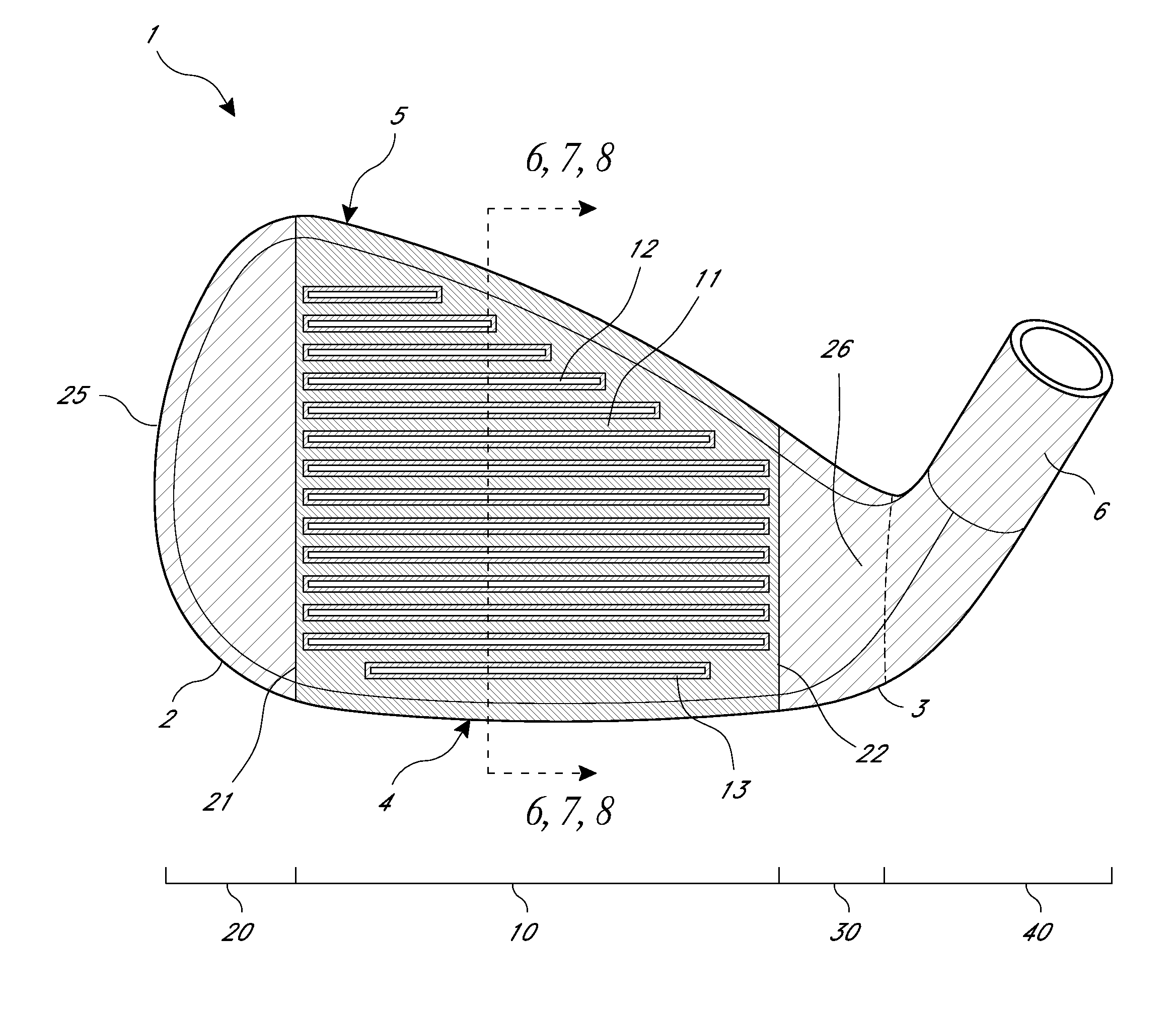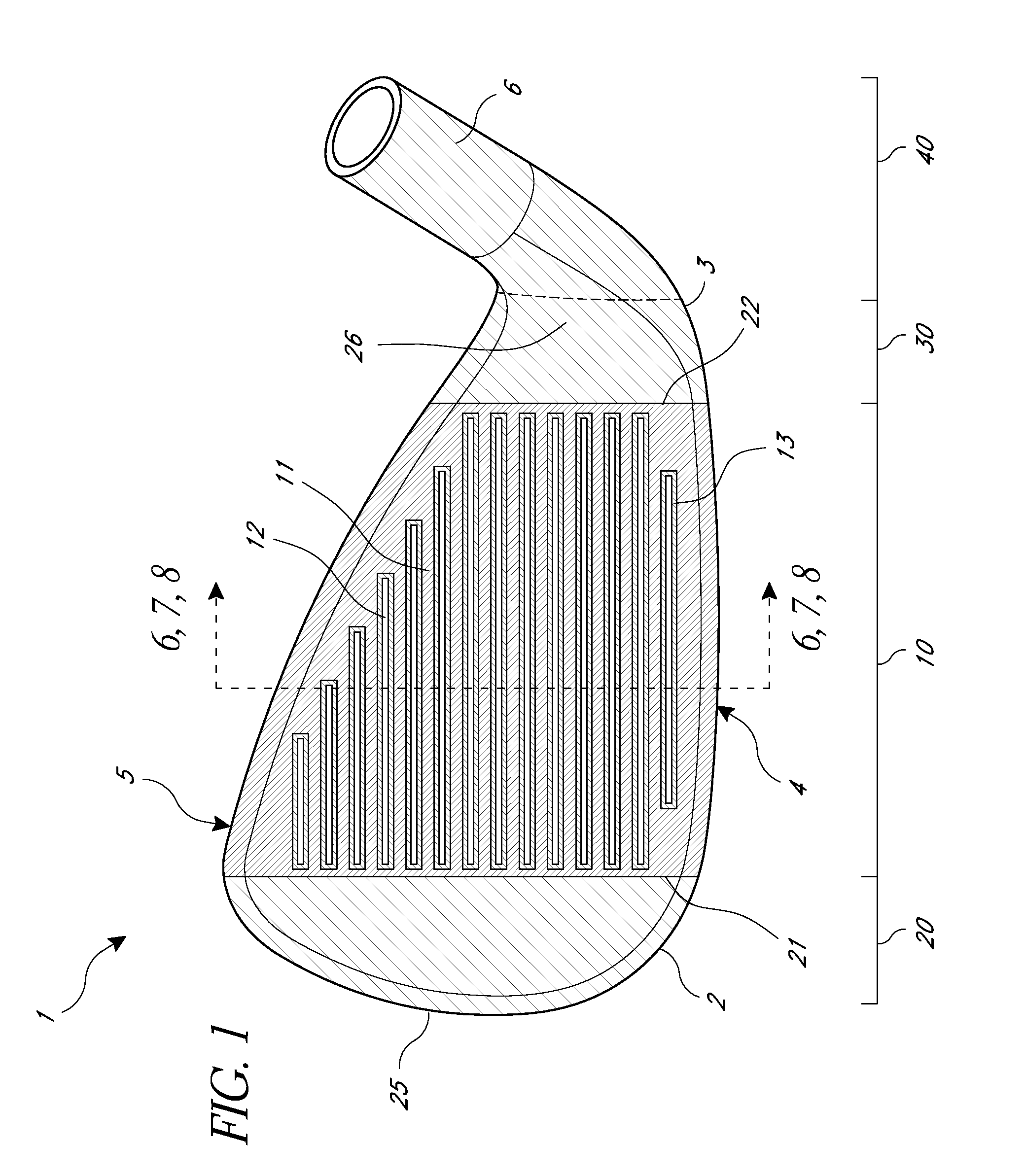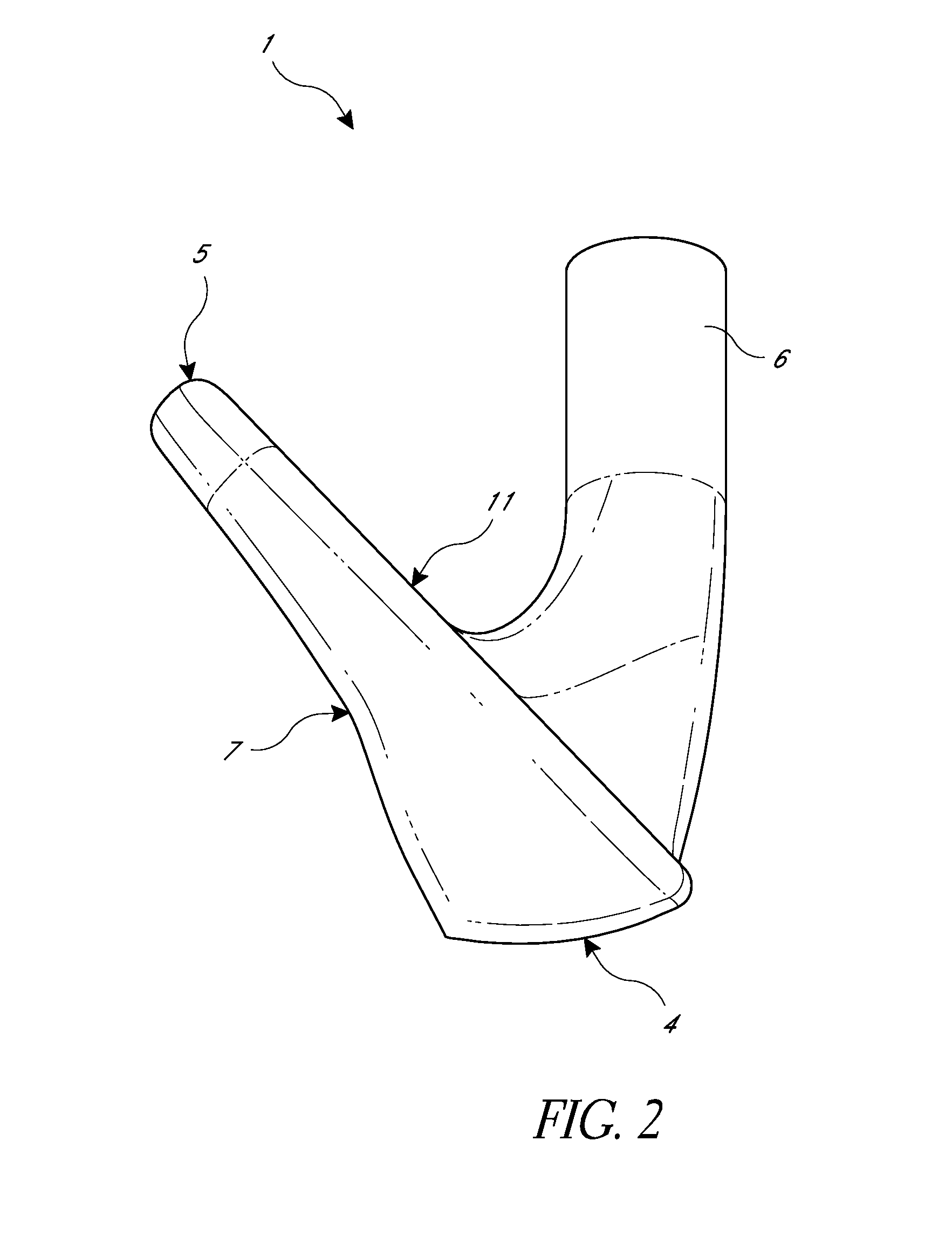[0008]Golfers generally prefer iron golf clubs, particularly wedges, to be designed to produce the maximum of ball backspin. Generally, a large amount of ball backspin producing capability is desired for wedges, which are high lofted iron clubs (e.g., 45° to 70° loft angle). The large amount of ball backspin in a
short distance golf shot (e.g., 5 to 100 yards) generally results in the golf ball taking a slightly lower trajectory, and stopping in a
short distance upon hitting the ground, especially in soft turf conditions. In comparison, a golf club that does not produce a large amount of ball backspin results in a golf shot that has a higher trajectory, and which rolls a considerable distance beyond the point where it first hits the ground (“roll-out”). For many golfers, backspin is highly desirable for situations requiring a precise
landing zone. For example, in a situation where the pin is located in a narrow portion of the green (and surround by hazards), a golf shot with large amounts of backspin is desirable because the golfer only has to consider where to land the ball, and the backspin will cause the ball to remain where it landed. In comparison, if the golfer used a wedge incapable of producing high amounts of backspin, the golfer would likely have to land the ball well before the pin, perhaps even before the green, which may result in a short shot that falls into a near-side
hazard. If the golfer lands the ball on the green, the ball may roll away and
trickle into a far-side hazard because of the lack of ball backspin preventing roll-out.
[0010]Various groove geometries, materials, and surface finishes have been implemented in order to achieve greater ball backspin on iron golf clubs, especially for wedges. With respect to groove geometries, a larger
groove width and a larger groove depth generally results in greater ball backspin. Larger groove volume also generally results in greater ball backspin. Groove geometries where the
radius between the groove side wall and the golf club striking face is small and sharp generally results in greater ball backspin. With respect to materials, softer materials including elastomeric ones generally create greater ball backspin. With respect to surface finishes, with a rougher finish, generally the result is greater ball backspin. These design differences achieve greater ball backspin by generally either increasing the friction between the ball and the golf club, or by reducing the interference of friction-reducing artifacts, such as channeling away water and debris using large volume grooves.
[0014]Given the proportionally greater expectation for precision with higher lofted wedges, the ball back-
spinning ability of the wedges is very important. The ball back-
spinning ability of the wedges is even more important when used to escape a
bunker or rescue a ball from the heavy rough. For example, when striking a ball from the heavy rough, grass and water will typically be trapped between the ball and striking face upon
impact. The grass and water will dramatically reduce the resulting ball backspin, because they interfere with the clean, friction-producing striking face of the golf club. However, large grooves on a golf club may allow the grass and water to be channeled away, thereby resulting in greater ball spin than with smaller grooves. However, even with large grooves, it is often the case that a ball hit from the rough will have less backspin than the same ball hit from the fairway, because inevitably some grass and water will interfere with the striking face of the club.
[0015]As it is evident to the golfer of ordinary skill in the art, golf is as much a mental challenge as it is a physical challenge. The mental aspect can be highlighted in the frequent occasions where a golfer misses a critical five foot putt (perhaps for a championship win)—where five foot putts in noncompetition situations are consistently made, even by young children. Especially with respect to golf irons and especially wedges, it is imperative for the golfer to have the utmost confidence in the golfer's clubs. For example, for distance control, a golfer may demand that the golfer's 7 iron (e.g., 36°) travels precisely 150 yards, and the golfer's 8 iron (e.g., 40°) exactly 10 yards less at 140 yards. For wedges that are specialized for the short game, distance control is even more important. For example, the golfer may demand that for a 15
yard chip shot, the golfer's sand wedge (e.g., 54°) travels 7.5 yards in the air, and rolls 7.5 yards after landing, while if the golfer used the golfer's lob wedge (e.g., 60°), the golfer may expect the ball to travel 10 yards in the air, and roll 5 yards. Thus, the consistent performance of a golfer's golf clubs inspire confidence, which usually leads to better accuracy and scores.
[0016]In addition to confidence from consistently performing golf clubs, the golfer gains confidence from golf clubs that generally inspire confidence due to their design. For example, a large, 460 cc driver may instill confidence in a golfer because the large club head looks like the golfer can swing for the fences and never worry about mis-hitting or missing the ball. Similarly, for golf irons and especially wedges, large grooves inspire confidence because the golfer is convinced that the club will generate massive amounts of ball backspin, allowing the golfer to precisely hit the golfer's target and not roll-out. Moreover, design features that emphasize the large grooves, such as contrasting colors, will further instill confidence by making the large grooves appear even bigger than they are physically.
[0018]In one embodiment of the invention, the grooves of a golf club iron head are surrounded by groove enhancement areas that have a surface finish identical to that of the grooves, but different from the remainder of the striking face. This results in the appearance that the grooves are as large as the grooves plus the surrounding groove enhancement areas, without breaking the USGA design rules. For instance, the confidence derived from the
perception that the grooves are larger than they are physically, could cause a golfer to hit the ball with more purposeful intent. That is, to confidently hit the ball with an accelerating blow, which will produce a good amount of ball backspin—as opposed to glancing the ball with a decelerating swing, which leads to a lack of ball backspin, which may be the case if the golfer lacks confidence in his golf club.
 Login to View More
Login to View More  Login to View More
Login to View More 


